TEXTUS: Nancy Mattson visits a richly rewarding exhibition of text and textiles at the Torriano Meeting House

Visiting the Torriano Meeting House this summer, I became totally absorbed in this quiet yet sophisticated exhibition which runs until 3 September. The curators, Lottie McCrindell and Keziah Florin-Sefton, have brought together and imaginatively displayed the works of over 30 poets and textile artists. The result is a many-layered exhibition held together by one theme with many variations. Each piece has its own integrity, purpose and voice, and they talk to each other – and to the viewers – in surprising ways.
TEXTUS: in-between text and textile. The title comes from the Latin root that links words and cloth. It’s pretty obvious that the words ‘text’ and ‘textile’ are related, but what does ‘textus’ mean? Poet and translator Robert Bringhurst reflects on this word in his classic book on typographic style:
An ancient metaphor: thought is a thread, and the raconteur is a spinner of yarns
— but the true storyteller, the poet, is a weaver. The scribes made this old and
audible abstraction into a new and visible fact. After long practice, their work took
on such an even, flexible texture that they called the written page a textus, which
means cloth.
[Robert Bringhurst, The Elements of Typographic Style, 1992, 3rd ed. 2008, p. 25]
.
.
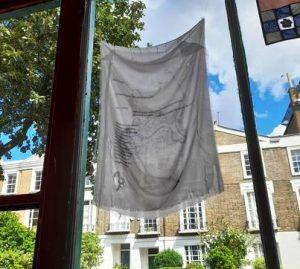
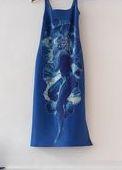
What stories are being told and woven together in this exhibition? When I entered the modest Torriano space that I know so well from years of attending poetry readings there, my first impression was delight at all the paper things and fabric things hanging from strings and threads, flowing free in the windows, 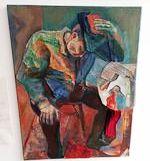 unattached to the walls. I revelled in the colours and textures – flimsy gauze, flowing silks, cotton remnants. A couple of fabric collages caught my eye, one a mountain landscape, the other a woman’s face with a round O mouth and words made of cutout letters. An apron of woven paper strips with a challenging repeated text hung on another wall. Tiny patchworks floated here and there. A large painting fused layers of cloth and paint to portray an old man slumped over a table, his wine spilling onto the floor.
unattached to the walls. I revelled in the colours and textures – flimsy gauze, flowing silks, cotton remnants. A couple of fabric collages caught my eye, one a mountain landscape, the other a woman’s face with a round O mouth and words made of cutout letters. An apron of woven paper strips with a challenging repeated text hung on another wall. Tiny patchworks floated here and there. A large painting fused layers of cloth and paint to portray an old man slumped over a table, his wine spilling onto the floor.
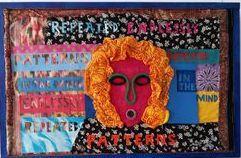
Poems on various types of paper hung from the ceiling, some threaded together. A translated poem about a carpet was printed in each language on two layers – tracing paper above standard paper. Some poems were printed or hand-drawn on fabrics. Hanging from a branch was a slinky blue dress overprinted in white with a flower and a nude woman. Sitting on a table was a pair of red denim Levis with a palindromic poem hand-painted in white on the legs, front and back; I was free to fold and refold the jeans to create new words and phrases.
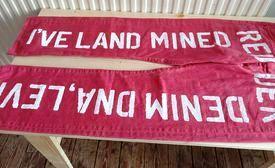
Then I looked around the room again. Four shiny red footstools were stuck on the steps to the stage, each with a distorted shiny red shoe glued on top. No one could walk in those shoes. I saw two poems on the piano top: one in a frame about Michelle Obama’s knitting, the other about a father’s brown leather gloves – where else would he have left them? Pinned to the Torriano’s familiar antique burlap or hessian screen, embroidered with birds and flowers, was a poem about the Bayeux Tapestry. Pages of a magazine were crocheted together with red yarn to make a stiff garment. Hmmm. Something unusual was going on here: the curators had chosen and displayed the pieces with clever, seemingly random intent, juxtaposing them so they could talk to each other – and to me.
On my first visit, Lottie told me background stories of the artists and writers as we walked around the exhibition. On my second visit Keziah, aka, Kezzie was on hand to answer any questions, tell more stories and make me and other visitors feel welcome.
These conversations were both friendly and useful, because there are no labels to identify the makers or explain their works, as there usually are in a gallery. I liked the egalitarian and inclusive atmosphere of the exhibition – not a place for inflated egoes, brash publicity, sales pitches or celebrity hype. The makers trust the curators, and both trust us as viewers to discover and interpret the works for ourselves. I found this liberating: it’s sometimes annoying to be spoon-fed by ‘artsplainers’, overwhelmed with information, or steered down specific ideological or aesthetic paths. Instead, the artworks and poems quietly revealed their own stories, some playful, some disturbing. They took me down memory lanes and into subconscious feelings, brought new ideas to mind. Took me places I’d never been, such as the Punjab or Beirut.
Everyone has memories – tender or painful, rough or smooth – of clothes, shoes, gloves, knitted jumpers with holes, overcoats, carpets, bedspreads. I was impressed by the quality of each piece and intrigued by each maker’s approach to the TEXTUS theme. But I wanted to know more about the unnamed makers! Of course, the curators had thought of that and provided a handy guide – not a slick catalogue but nevertheless comprehensive and detailed. Nine stapled A4 pages, photocopied double-sided, gave me a hand-drawn and numbered map to locate and identify each piece in the room, and a brief bio of each maker.
I was struck by the multicultural and inclusive range of the artists and writers, about two-thirds women. They hail from or have roots in places including Pakistan, South Asia, Italy, Brazil, the US, France, Russia, Cornwall, New Zealand, Hungary, Scotland, England, Germany. There are published poets, new and well-established artists, sculptors and filmmakers, academics – all respected and known in their own circles. I was impressed by the range of contacts that Lottie and Kezzie have, but they assured me that they had sent out an open call for submissions in order to widen their frame of reference.
Here are their names, so you too can look them up on the internet: Timothy Adès, Jennifer Aldred, Anouk Beckers, Victoria Adukwei Bulley, Oliver Comins, Jo Cope, Josephine Corcoran, Natalie d’Arbeloff, Keri Finlayson, Jackie Goode, Sylee Gore, Shelly Goldsmith, Rose Higham-Stainton, Raisa Kabir, Lisa Kelly, Chris Kerr, Rohma Khan, Henrica Langh, Emma Lee, Patrizia Longhitano, Stuart McKenzie, Siobhan McLaughlin, Chika Oduah, Ben Philipps, Nina Mingya Powles, Lavinia Singer, Kathryn Southworth, Keziah Florin-Sefton, Lottie McCrindell, Tim Waller, Ellis Warren, Grace Warren, Thomas Whittaker, Stephen Paul Wren, Onosiokhue Yakubu.
I haven’t yet mentioned the two films. I’d like to highlight one of them, a powerful film- poem by Chika Oduah entitled ‘The Beautiful Load’. You can find it on YouTube, only five minutes long. When I sat in a small corner of the Torriano and put on the earphones, I entered the world of women from many African nations, wrapping vibrant fabrics around their heads in their bedrooms while Chika recited her poem for them. Honouring their minds and creativity, she calls it ‘an ode to the black woman’s headscarf and all that she carries’. Here’s a multilingual excerpt, as transcribed from the video:
… the African woman, making something out of nothing and then calling it for many tongues:
ichafu for the Igbo,
moussor for the Wolof,
kitamabaa cha kichwas for the Swahili,
tiguon for the Creoles,
tukwi for the Tswanas of Botswana,
duku for the Ghanaians,
chitambala for the Zambians,
gele for the Yoruba,
we make this thing, and with every grimace of her face to make this thing,
with every grimace in which her lips contort and her brows crinkle and her
shoulders sag under ungodly burdens and her back aches with the aftershocks
of men attacking her earth and her nights tormented by ungodly nightmares
and her pride bruised by racist blows,
with every grimace of her face she forges ahead with her head up …
In another haunting political piece, Rhoma Khan etches into her heirloom chador a poem by Amrita Pritam in two scripts – Gurmukhi and Shahmukhi – addressing the 1947 partition of Punjab. The English translation of the poem is in a small library in the room.
And finally, I would be remiss if I didn’t offer a few lines of poetry that pick up some of the threads running through the exhibition:
and found in the rhythm of their clicking / the text to fight despair
-Kathryn Southworth, ‘Michelle Obama’s knitting’
and-the-by and-the-with and-the-constant-from /
of your endlessly / flowering / breath
-Keri Finlayson, ‘Bedspread 1974’
We are kin. Our bones and bodies are made of the same stuff. We breathe the same air,
drink the same water, exist under the same stars, all of nature connected.
-Shelly Goldsmith, ‘We are kin’
But what if the process removes the scent?
-Tim Waller, ‘Leather Coat in the Hall Closet’
Tell me, I said, about what has survived. / Tell it with only two threads and your hands // …
Even a rug of dust & earth is fit for prayer.
-Victoria Adukwei Bulley, ‘Until the fabric speaks & the textile is a text’
The breeze breathes through them, / bullies the dresses into ghosts, /
brides with no substance, / angels bereft of their voices
-Emma Lee, ‘The Bridal Dresses in Beirut’
In the very act of not forgetting – I am picking up my needle / and threading
its clear-sighted eye – / while my mind’s eye – is remembering the act of repairing
-Lisa Kelly, ‘Ode to Not Forgetting’
And so this exhibition brings an ‘ancient metaphor’ up to date in tangible form, blending the intimacy of lyric poetry with the intimacy of fabrics in dynamic, instinctive, bold and subtle ways. Every piece is thoughtful and successful on its own terms. On their own terms. On our own terms.
I am grateful to every maker and to the curators and their assistants. And I acknowledge with thanks Susan and Emily Johns and the late John Rety who envisioned the Torriano Meeting House as a space for conversation, creativity and community. Long may it continue to be characterized by radical and beautiful inclusiveness.
.
TEXTUS runs until 3 September 2023 at the Torriano, 99 Torriano Avenue, London, NW5 2RX. The exhibition is curated by Keziah Florin-Sefton and Lottie McCrindell. With assistance from Onosiokhue Yakubu, Isobel Landell Mills, Phoebe Ingleby and Miriam Agiru. If you would like any further information or images of the selected artworks, please email: textus.network@gmail.com. And TEXTUS also means that you’re invited to text your reactions! @textus.network
Aug 21 2023
TEXTUS at the Torriano
TEXTUS: Nancy Mattson visits a richly rewarding exhibition of text and textiles at the Torriano Meeting House
Visiting the Torriano Meeting House this summer, I became totally absorbed in this quiet yet sophisticated exhibition which runs until 3 September. The curators, Lottie McCrindell and Keziah Florin-Sefton, have brought together and imaginatively displayed the works of over 30 poets and textile artists. The result is a many-layered exhibition held together by one theme with many variations. Each piece has its own integrity, purpose and voice, and they talk to each other – and to the viewers – in surprising ways.
TEXTUS: in-between text and textile. The title comes from the Latin root that links words and cloth. It’s pretty obvious that the words ‘text’ and ‘textile’ are related, but what does ‘textus’ mean? Poet and translator Robert Bringhurst reflects on this word in his classic book on typographic style:
What stories are being told and woven together in this exhibition? When I entered the modest Torriano space that I know so well from years of attending poetry readings there, my first impression was delight at all the paper things and fabric things hanging from strings and threads, flowing free in the windows, unattached to the walls. I revelled in the colours and textures – flimsy gauze, flowing silks, cotton remnants. A couple of fabric collages caught my eye, one a mountain landscape, the other a woman’s face with a round O mouth and words made of cutout letters. An apron of woven paper strips with a challenging repeated text hung on another wall. Tiny patchworks floated here and there. A large painting fused layers of cloth and paint to portray an old man slumped over a table, his wine spilling onto the floor.
unattached to the walls. I revelled in the colours and textures – flimsy gauze, flowing silks, cotton remnants. A couple of fabric collages caught my eye, one a mountain landscape, the other a woman’s face with a round O mouth and words made of cutout letters. An apron of woven paper strips with a challenging repeated text hung on another wall. Tiny patchworks floated here and there. A large painting fused layers of cloth and paint to portray an old man slumped over a table, his wine spilling onto the floor.
Poems on various types of paper hung from the ceiling, some threaded together. A translated poem about a carpet was printed in each language on two layers – tracing paper above standard paper. Some poems were printed or hand-drawn on fabrics. Hanging from a branch was a slinky blue dress overprinted in white with a flower and a nude woman. Sitting on a table was a pair of red denim Levis with a palindromic poem hand-painted in white on the legs, front and back; I was free to fold and refold the jeans to create new words and phrases.
Then I looked around the room again. Four shiny red footstools were stuck on the steps to the stage, each with a distorted shiny red shoe glued on top. No one could walk in those shoes. I saw two poems on the piano top: one in a frame about Michelle Obama’s knitting, the other about a father’s brown leather gloves – where else would he have left them? Pinned to the Torriano’s familiar antique burlap or hessian screen, embroidered with birds and flowers, was a poem about the Bayeux Tapestry. Pages of a magazine were crocheted together with red yarn to make a stiff garment. Hmmm. Something unusual was going on here: the curators had chosen and displayed the pieces with clever, seemingly random intent, juxtaposing them so they could talk to each other – and to me.
On my first visit, Lottie told me background stories of the artists and writers as we walked around the exhibition. On my second visit Keziah, aka, Kezzie was on hand to answer any questions, tell more stories and make me and other visitors feel welcome.
These conversations were both friendly and useful, because there are no labels to identify the makers or explain their works, as there usually are in a gallery. I liked the egalitarian and inclusive atmosphere of the exhibition – not a place for inflated egoes, brash publicity, sales pitches or celebrity hype. The makers trust the curators, and both trust us as viewers to discover and interpret the works for ourselves. I found this liberating: it’s sometimes annoying to be spoon-fed by ‘artsplainers’, overwhelmed with information, or steered down specific ideological or aesthetic paths. Instead, the artworks and poems quietly revealed their own stories, some playful, some disturbing. They took me down memory lanes and into subconscious feelings, brought new ideas to mind. Took me places I’d never been, such as the Punjab or Beirut.
Everyone has memories – tender or painful, rough or smooth – of clothes, shoes, gloves, knitted jumpers with holes, overcoats, carpets, bedspreads. I was impressed by the quality of each piece and intrigued by each maker’s approach to the TEXTUS theme. But I wanted to know more about the unnamed makers! Of course, the curators had thought of that and provided a handy guide – not a slick catalogue but nevertheless comprehensive and detailed. Nine stapled A4 pages, photocopied double-sided, gave me a hand-drawn and numbered map to locate and identify each piece in the room, and a brief bio of each maker.
I was struck by the multicultural and inclusive range of the artists and writers, about two-thirds women. They hail from or have roots in places including Pakistan, South Asia, Italy, Brazil, the US, France, Russia, Cornwall, New Zealand, Hungary, Scotland, England, Germany. There are published poets, new and well-established artists, sculptors and filmmakers, academics – all respected and known in their own circles. I was impressed by the range of contacts that Lottie and Kezzie have, but they assured me that they had sent out an open call for submissions in order to widen their frame of reference.
Here are their names, so you too can look them up on the internet: Timothy Adès, Jennifer Aldred, Anouk Beckers, Victoria Adukwei Bulley, Oliver Comins, Jo Cope, Josephine Corcoran, Natalie d’Arbeloff, Keri Finlayson, Jackie Goode, Sylee Gore, Shelly Goldsmith, Rose Higham-Stainton, Raisa Kabir, Lisa Kelly, Chris Kerr, Rohma Khan, Henrica Langh, Emma Lee, Patrizia Longhitano, Stuart McKenzie, Siobhan McLaughlin, Chika Oduah, Ben Philipps, Nina Mingya Powles, Lavinia Singer, Kathryn Southworth, Keziah Florin-Sefton, Lottie McCrindell, Tim Waller, Ellis Warren, Grace Warren, Thomas Whittaker, Stephen Paul Wren, Onosiokhue Yakubu.
I haven’t yet mentioned the two films. I’d like to highlight one of them, a powerful film- poem by Chika Oduah entitled ‘The Beautiful Load’. You can find it on YouTube, only five minutes long. When I sat in a small corner of the Torriano and put on the earphones, I entered the world of women from many African nations, wrapping vibrant fabrics around their heads in their bedrooms while Chika recited her poem for them. Honouring their minds and creativity, she calls it ‘an ode to the black woman’s headscarf and all that she carries’. Here’s a multilingual excerpt, as transcribed from the video:
In another haunting political piece, Rhoma Khan etches into her heirloom chador a poem by Amrita Pritam in two scripts – Gurmukhi and Shahmukhi – addressing the 1947 partition of Punjab. The English translation of the poem is in a small library in the room.
And finally, I would be remiss if I didn’t offer a few lines of poetry that pick up some of the threads running through the exhibition:
and found in the rhythm of their clicking / the text to fight despair -Kathryn Southworth, ‘Michelle Obama’s knitting’ and-the-by and-the-with and-the-constant-from / of your endlessly / flowering / breath -Keri Finlayson, ‘Bedspread 1974’ We are kin. Our bones and bodies are made of the same stuff. We breathe the same air,drink the same water, exist under the same stars, all of nature connected. -Shelly Goldsmith, ‘We are kin’ But what if the process removes the scent? -Tim Waller, ‘Leather Coat in the Hall Closet’ Tell me, I said, about what has survived. / Tell it with only two threads and your hands // …Even a rug of dust & earth is fit for prayer. -Victoria Adukwei Bulley, ‘Until the fabric speaks & the textile is a text’ The breeze breathes through them, / bullies the dresses into ghosts, /brides with no substance, / angels bereft of their voices -Emma Lee, ‘The Bridal Dresses in Beirut’ In the very act of not forgetting – I am picking up my needle / and threadingits clear-sighted eye – / while my mind’s eye – is remembering the act of repairing -Lisa Kelly, ‘Ode to Not Forgetting’And so this exhibition brings an ‘ancient metaphor’ up to date in tangible form, blending the intimacy of lyric poetry with the intimacy of fabrics in dynamic, instinctive, bold and subtle ways. Every piece is thoughtful and successful on its own terms. On their own terms. On our own terms.
I am grateful to every maker and to the curators and their assistants. And I acknowledge with thanks Susan and Emily Johns and the late John Rety who envisioned the Torriano Meeting House as a space for conversation, creativity and community. Long may it continue to be characterized by radical and beautiful inclusiveness.
.
TEXTUS runs until 3 September 2023 at the Torriano, 99 Torriano Avenue, London, NW5 2RX. The exhibition is curated by Keziah Florin-Sefton and Lottie McCrindell. With assistance from Onosiokhue Yakubu, Isobel Landell Mills, Phoebe Ingleby and Miriam Agiru. If you would like any further information or images of the selected artworks, please email: textus.network@gmail.com. And TEXTUS also means that you’re invited to text your reactions! @textus.network